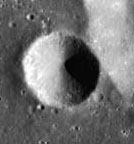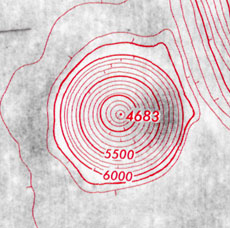-
Notifications
You must be signed in to change notification settings - Fork 1
Interpreting Crater Shadows
Examples...
The average shape of fresh craters on the Moon is thought to change systematically with diameter in a manner summarized in the September 23, 2004 LPOD. Craters with diameters less than about 10 km are said to be predominantly "simple" craters with bowl-like shapes; where "bowl" can evidently mean having either straight (conical) or curved (spherical or parabolic) walls, and with or without a flat portion of floor in the center. This page shows how Albategnius C appears when illuminated at a various sun angles, and compares the images to what would be expected with those lighting conditions for a pair of simple shapes generated with the Crater Shadows Simulator utility program.
This a Albategnius C as it appears in a low resolution scan of Apollo Panoramic image AS16-P-4640 :

It appears there may be a small flat section to the floor, but the resolution of the scan is not adequate to be sure.
Here are its contours as interpreted on LTO map 77-C1 :

The contours within the crater bowl seem to have been drawn with a constant spacing indicating a constant slope, although this may be reading more into the chart than was originally intended.
And here is a comparison of the observed shadow patterns at various sun angles and the patterns that would be expected for a spherical versus a conical shape. The images are mostly moderate resolution scans from the LPI (such as Apollo AS16-M-0708, plus the center image from Lunar Orbiter IV (frame 101H) :
The numbers below the photos are the sun angles. The observed pattern looks much closer to that expected for the conical shape than to that expected for a spherical bowl. The angles available are not adequate to rule out the possibility of a section of flat floor about 1 km in diameter. To reproduce the observed flaring out of the shadow near the top of the rim at high sun angles, the conical shape is not a pure cone, but rather one which has been numerically massaged to give it a bit of extra steepness at the top. LTVT now has the ability to directly record the radial height profile in a crater, so this kind of empirical manipulation of the profile should no longer be necessary.
A Simple Experiment with Shadows -  JohnMoore2
JohnMoore2
- Pike, R. J. 1974. Depth/diameter relations of fresh lunar craters - Revision from spacecraft data. Geophysical Research Letters, vol. 1, Nov. 1974, p. 291-294.
- Ravine, M. A.; Grieve, R. A. F.; Edrington, R. S.; Meglis, I. L. 1984. Morphometric Analyses of Lunar Impact Craters. LUNAR AND PLANETARY SCIENCE XV, P. 669-670. Abstract.
- Wood, C. A.; Anderson, L. 1978. New morphometric data for fresh lunar craters. In: Lunar and Planetary Science Conference, 9th, Houston, Tex., March 13-17, 1978, Proceedings. (A79-39253 16-91) New York, Pergamon Press, Inc., 1978, p. 3669-3689.
This page has been edited 4 times. The last modification was made by -  JohnMoore2 on Jan 18, 2009 4:26 am
JohnMoore2 on Jan 18, 2009 4:26 am